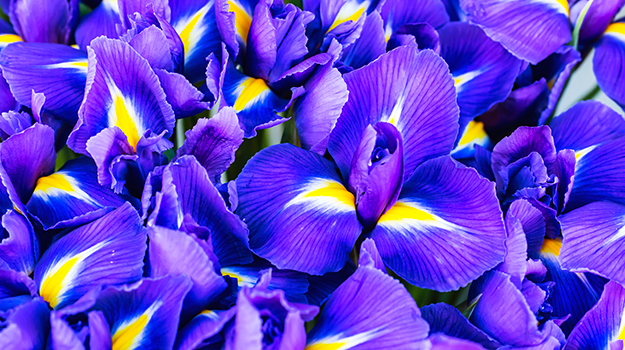
Although some bulbs can be planted in June, it is usually in the fall that we plant those that will bloom in spring. In this article, we are not talking about tulips and narcissus, but rather about their precursors… the first bulbs to flower.
Somewhat little known, their flowers nevertheless offer a lively and unusual spectacle, at this time of year when nature wakes up lazily, and much too slowly for our taste. Planting early spring bulbs is a wonderful way to transform an unattractive lawn into a dazzling flower bed!
By planting different varieties of early bulbs, you could have flowers from the snowmelt until the lawn begins to green, which is almost a month and a half. But to be able to enjoy them, they will have to be planted in the fall. If the conditions are right, they will multiply and bloom each spring, for decades to come.
A carpet of flowers in spring: the principle of the flower lawn
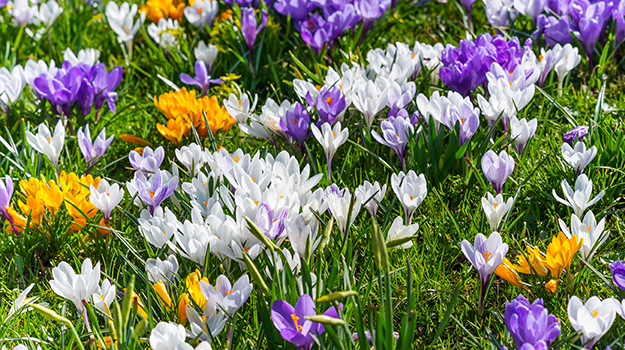
Interestingly, the alpine meadows that inspired our lawns are dominated by grass in summer but covered in flowers in early spring. This confirms how well grasses and bulbs, by nature, go together.
This beautiful cohabitation is explained by the fact that the two plants have an opposite life cycle. From fall to spring, the grasses that make up our lawns go dormant, while the early-flowering bulbs begin to develop. The latter will continue their process under the snow in winter, then develop timid foliage and bloom in early spring. By the time the grass begins to turn green again, the bulbs have finished their magnificent show and are quiet again, finally going dormant during the summer.
So, you can mow the lawn as usual, without worrying about spring bulbs. They seem made to share a same location, right?
PRO TIP: Only early flowering bulbs are suitable for planting in the lawn, as they will be the only ones to have completed their growth cycle before the lawn needs to be mowed. Forget narcissus, tulips, alliums and even grape hyacinths, which will not have time to bloom!
Bulbs at the foot of tall trees
Is the thought of planting bulbs in a neatly manicured lawn breaking your heart? Think of places where the grass is sparse, such as at the base of tall trees. Your early flowers will be gone once the tree buds turn into dense foliage that barely lets the sunshine through. They will have their time and place in the sun and will not begrudge the fact that you planted them in the shade!
A bulb-covered undergrowth is also magical! Pick bulbs that are adapted to this environment. If the ground is too hard to plant in, add good soil to the base of the trees and plant between the roots! Once again, cohabitation can be done in harmony.
A solution for lawns in distress?
It must be remembered that the early bulbs that are planted in the lawn are not there to last. It is therefore not a miracle option to save a lawn in decline. Especially since, if the grass is doing badly in one place of your yard, the bulbs will probably not like it either.
Consider topdressing your lawn every year, adding 2 cm of good soil every fall. Also apply compost and overseed with a grass seed mix suitable for shady or sunny conditions. Your soil will contain more nutrients, your lawn will be healthy, and your bulbs will multiply quickly.
How to plant bulbs?
The easiest way to plant bulbs in the ground is to group them in a common cavity rather than digging individual holes. This process is easier and faster.
In the lawn, individual holes dug with a bar have the disadvantage of compacting the soil around the hole, but this solution is still OK if you do not want to take more extensive measures. The other technique is more extreme since it involves digging out the lawn to a depth of 8 cm on three sides (almost as if you wanted to remove it) and folding it backwards. You will get a planting hole with the ideal depth. Then fold the lawn back on top of the bulbs.
Add mycorrhizae to the soil, then arrange your bulbs, spacing them about 3 times their diameter apart or as recommended on the packaging. Although they can find their way above ground and flower even when planted the wrong way up, they should be placed pointing up. The flat part, from which some roots may already emerge, is called the basal plate. In the case of bulbs that do not have the shape of a teardrop, there is no precise direction, so no need to rack your brains.
As the bulbs rarely have dense foliage, they are planted in groups rather than by themselves… and in large numbers. For a beautiful effect, plant small bulbs, such as crocuses, squills and snowdrops, in groups of 25 or more… Otherwise the flowers will be lost in the landscape!
The more bulbs, the more spectacular the effect. Small bulbs are inexpensive and come in packages that often contain a large number. Also note that some multiply rapidly over the years, so even if the result is not what you hoped for in the first spring, you lose nothing by waiting!
OUR TIP FOR LONG-TERM FLOWERING: Plant very early bulbs, such as eranthis and snowdrops, and others that flower immediately afterwards, such as anemones, snow glories, puschkinias and crocuses, and later ones like scillas.
The different early flowering spring bulbs
The following suggestions fall into the category of small bulbs. They are ideal for naturalizing lawns.
Snowdrop (Galanthus nivalis)
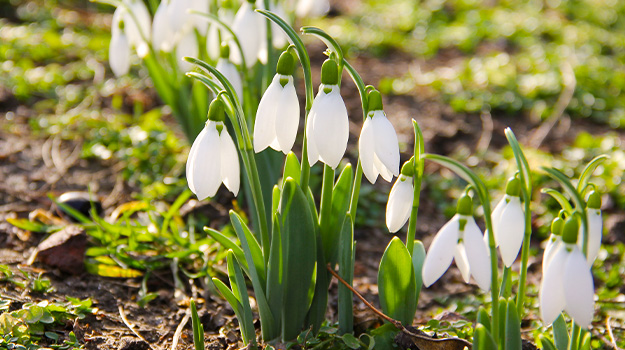
With its height of 15 to 30 centimetres, it sways elegantly in the wind... sometimes a few centimetres up from a mound of snow. This small plant with ribbon-like leaves like those of a grass has an arching flower stem. Its pure white hanging flower bows modestly to the ground, and yet the snowdrop is majestic. Turning the flower over reveals a delicate green and white crown surrounded by three white sepals.
It is planted in the fall, pointing upwards and at a depth of 8 to 10 centimetres, in a well-drained place that benefits from the spring sun. It works wonders at the foot of trees, between perennials in the shade. Divide the bulbs after flowering to multiply them since they do not reseed easily.
Eranthis or winter aconite (Eranthis hyemalis)
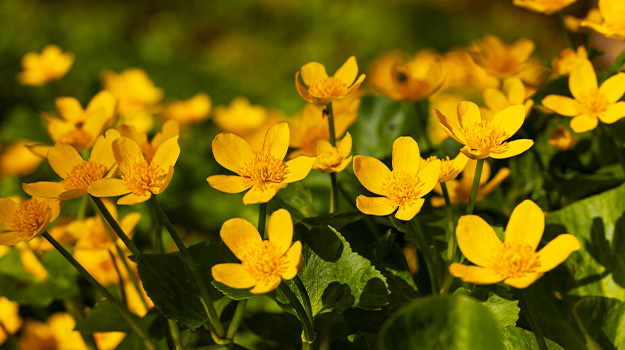
The eranthis is small (often no more than 5 to 10 centimetres high), but very showy with its bright yellow flowers that celebrate the arrival of spring. Each bulb produces a short stem on which two finely cut leaves form an elegant collar under a single flower.
To guarantee its flowering, it must be planted very early, as soon as it arrives in stores in September or at the beginning of October. You increase your chances of success by soaking the bulbs in water for 24 hours before planting them and by adding mycorrhizae to the planting hole. Once well-established, eranthis appreciate the addition of a slow-release fertilizer in the spring. It will then multiply unaided, by seed, until it forms a dazzling carpet.
Although it has not been scientifically proven, the eranthis could be among the thermogenic plants, which are plants that produce heat at the time of flowering to attract particularly early pollinators and allow them to warm up before continuing collecting pollen.
Corydalis (Corydalis)
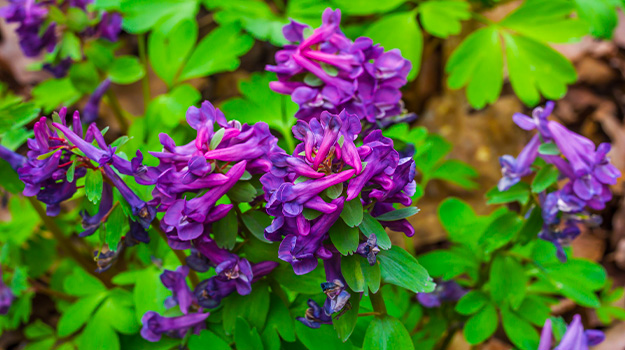
Despite its small size of less than 20 centimetres, the corydalis makes a grand display in the spring. If its growing intensity can make one think of an invasion, it grows big but causes no harm to other plants. Their finest hour will come soon enough once the other plants have faded into the landscape and gone dormant in the ground.
This plant is native to Europe and grows as far as Siberia. Its leaves are like those of columbine, and its flowers, purple, pink, red or white, in clusters of about twenty florets. Each flower is set with a long erect spur, slightly curved backwards, reminiscent of the tuft of the horned lark (“korydallis” in Greek). That's where its name comes from.
Corydalis prefers well-drained soils rich in organic matter but tolerates temporarily soggy soils in the spring. We can replicate its natural environment by spreading a generous layer of mulch at its feet. It tolerates partial shade, but prefers shade, which makes it a plant of choice for places where we are desperate to see anything bloom one day.
It multiplies freely by seed. You can try to collect its seeds to flower another part of the garden, but it is difficult to know when. You must do it before the capsule bursts and drops its seeds. This plant doesn't really give any clues. If you manage to collect the seeds, note that they must be planted immediately, as they are not viable for long. Moving young plants is therefore much easier.
Its bulbs do not tolerate storage well and are therefore rarely offered in stores. However, they can be ordered from Fraser's Thimble Farms, Veseys and Breck's. The Horticlub catalogue also offers a brand new variety with dark pink flowers.
Netted or dwarf iris (Iris reticulata)
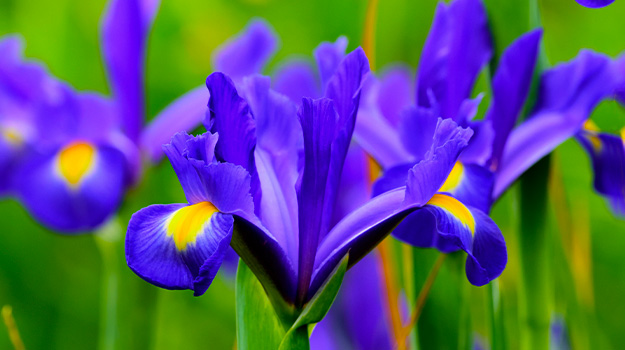
This would be the first variety of iris to rise out of the ground. Unlike tall irises that grow by rhizomes, netted irises are small bulbous plants. In fact, small is a big word since what characterizes this strain is that it produces surprisingly large flowers on a tiny plant.
The barely 15 cm high plant displays flowers with a diameter of almost 10 centimetres. As the number of bulbs multiply over time, they end up forming a stunning carpet that is both dense and wonderfully detailed. The name of the plant means “rainbow”. This iris is available in an array of colours from royal blue to lilac and from violet to purple red, in addition to offering white or yellow cultivars.
In a temperate climate, the netted iris can sometimes be seen before the end of winter, bravely emerging from the snow. Its flowering period may vary from place to place, but it is definitely one of the first flowers to greet the arrival of sunny days.
There is a wide variety of netted irises, but garden centres often only sell one or two. By mail order, the choice is impressive. Take the time to find out; some yellow cultivars bloom only once every two or three years. A brand new variety has just arrived: in addition to its unique colouring of a blue-green adorned with yellow and black, it multiplies at an astonishing speed. A plantation of ten bulbs gives rise, three or four years later, to more than a hundred flowers.
TIP: Squirrels don't like iris bulbs. So, you don't have to worry about them being moved or eaten!
Crocus (Crocus spp.)
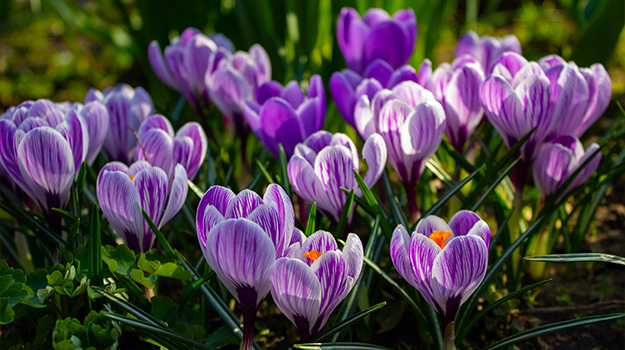
The crocus flowers a few days after the snowdrops and the eranthis. That said, planted near a south-facing foundation, a flower could very well surprise you as early as mid-March.
There is an impressive number of crocuses to choose from, several being offered in stores: small-flowered, large-flowered, very early, medium-early or mid-season flowering, purples, whites, blues, lilacs, yellows… Most are bicolour or tricolour, with an elegant yellow throat.
Easy to grow, once planted, crocuses multiply quickly. They are content with a sunny location in the spring and well-drained soil. As they are alpine plants, the problem of soggy soils can be circumvented by planting the bulbs in rock gardens or raised beds. Dormant during the summer, crocuses begin to produce roots when the temperature drops, continuing to grow through the winter. They will bloom every spring for decades if you don't mow their foliage until it has started to yellow.
GOOD TO KNOW: There are fall-flowering cultivars, the best known being the saffron crocus. Yes, the saffron so popular in the kitchen comes from this plant. This spice, recognized as being the most expensive in the world, has been produced in Quebec for several years. Its orange stigma is harvested to dry. This crocus needs to be planted in early fall or it will bloom in its wrapper!
Siberian squill (Scilla siberica)
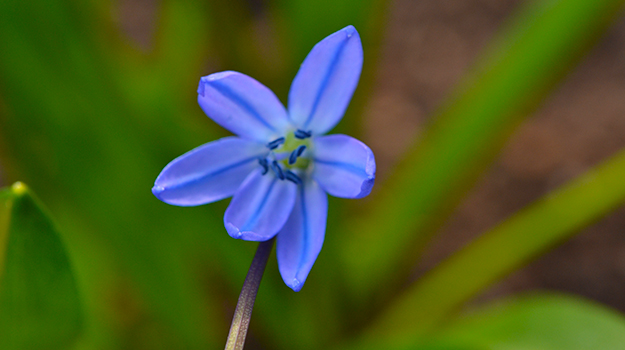
The Siberian squill is exceptional, and not only because of its flowering which can last up to six or seven weeks, from mid-March to May. Sixteen centimetres tall, it flowers profusely and quickly covers very large areas at the foot of trees, in rock gardens or lawns.
Originally from Eurasia, it is part of the same family as the trilliums, native to Canada. Each bulb carries one or two bent flower stems decorated with a starry blue flower delicately leaning towards the ground. The cultivar Alba bears pure white flowers.
Siberian squill grows almost anywhere and flourishes in both sun and shade. It appreciates the addition of mycorrhizae at planting, and thrives in rich or poor, acidic or alkaline, dry or moderately moist soils. However, it hardly tolerates soggy soils. As its bulb must dry out a little during the summer, you should avoid automatically irrigated sites that would be constantly watered.
The plant being tiny, the bulbs must be planted in groups. Squill will reseed abundantly and quickly to create striking effects. In a few years, a plantation of ten bulbs will give rise to a sumptuous carpet of about one square metre. In fact, it spreads so easily that neat lawn enthusiasts consider it an invasive weed. Obviously, the two can be neighbours without any problem, as when the lawn turns green and beautiful again, the squills will have completely disappeared.
Glory of the snow (Chionodoxa)
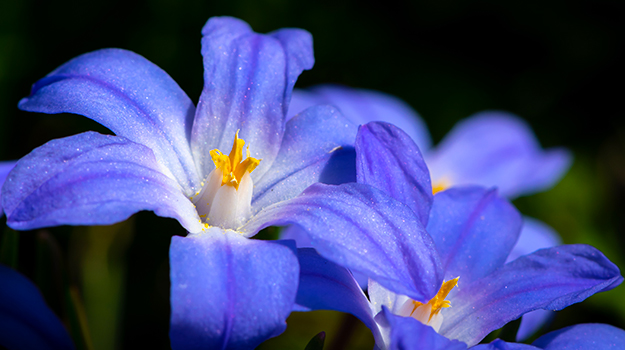
In its native European mountains, the glory of the snow blooms as the snow melts. In Eastern Canada, we have to wait until the end of April or the beginning of May to see it appear.
Its branched flower stalk bears several star-shaped flowers of a violet blue, with a touch of white. Some cultivars also offer white or pink flowers. Although delicate in appearance, it is resistant to insects and diseases, and hardy to zone 3. It is also very generous: a single bulb will quickly divide into several.
The glory of the snow also spreads profusely by sowing its seeds on the fly. These will produce other bulbs which will flower two or three years later. For a grandiose effect, naturalize the bulbs in the lawn. After a few years, your sleeping lawn will be covered with lots of beautiful stars. At the time of the first mowing, all that will remain of the plant are a few yellowed leaves that look like blades of grass.
Striped or Lebanon squill (Puschkinia scilloides)
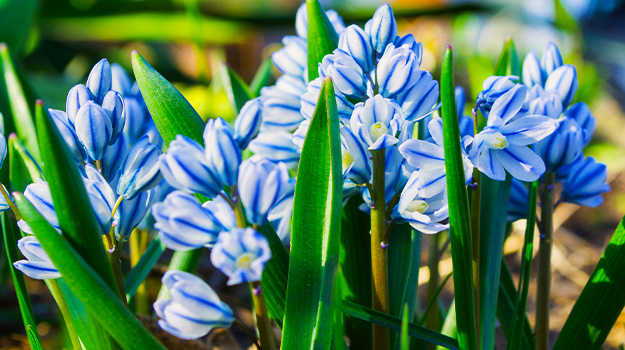
The flower of the puschkinia is reminiscent of the hyacinth. Its floral stem ends in a spike with six to twelve flowers. While there are varieties with blue flowers, most cultivars bear white bells marked with a blue line in the centre of the petals.
Native to the Middle East, where it proliferates in humid areas, puschkinia here prefers well-drained soil and a lightly shaded location. Very hardy and easy to grow, it flowers year after year and multiplies to quickly gain ground. Just wait for the foliage to fade completely before mowing the lawn. If necessary, it can also be moved at this time. Very pretty and less known than other spring bulb plants, it is sure to catch everyone’s attention.
Grecian windflower (Anemone blanda)
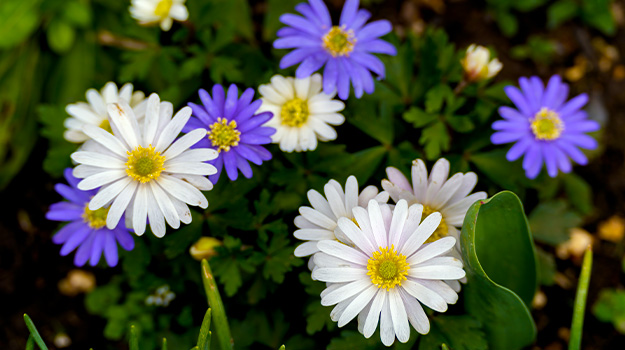
The Grecian windflower is without a doubt the spring bulb that blooms the longest, lasting a few weeks, starting in May. Some cultivars produce white flowers, while others come in an array of shades of blue or pink.
Its multi-petalled flowers resemble daisies or asters. Its delicate foliage is also very decorative. Soak the tubers in water for 24 hours before planting them.
